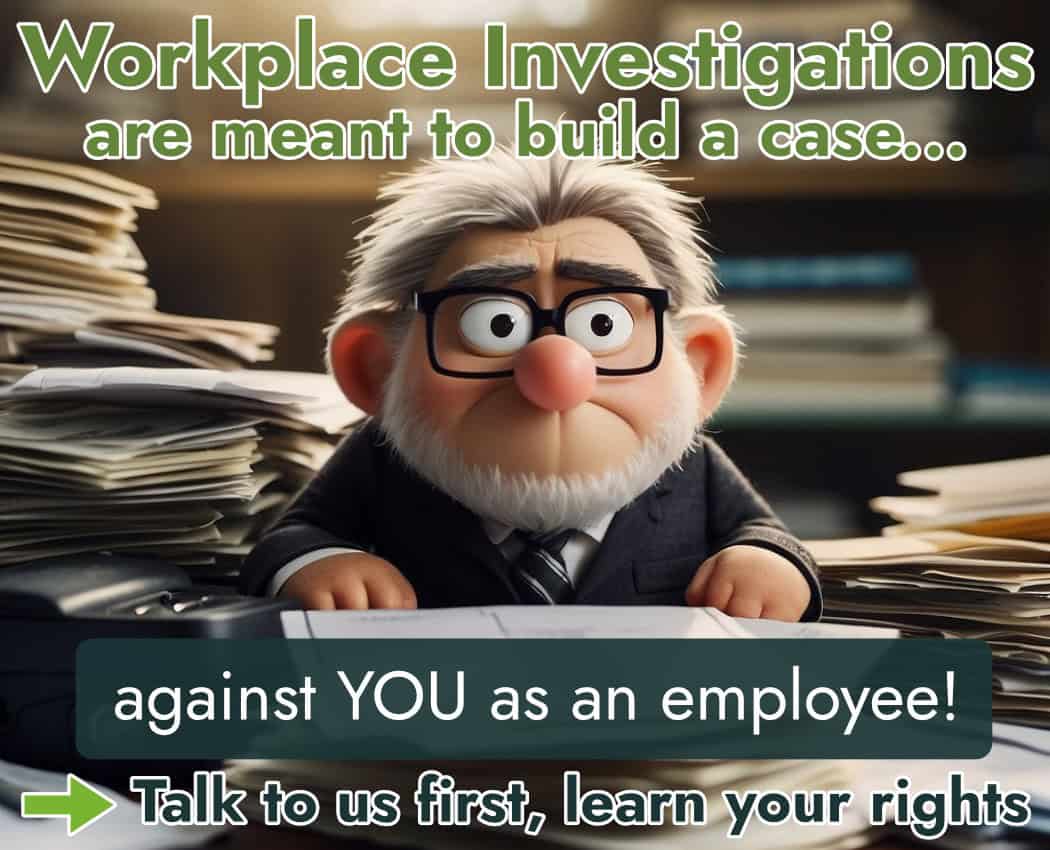
Constructive dismissal in Alberta refers to employer-instigated substantial work changes, forcing employees to resign. This could be a salary reduction, significant job duty changes, or a hostile work environment. Employees should be aware of their rights under Alberta’s Employment Standards Code and the Alberta Human Rights Act, which protect against such unfair changes and hostile environments. If an employee experiences constructive dismissal, they may seek legal advice to pursue a claim. Knowledge of the process, including evidence collection and legal timelines, is important for a successful claim. Additional details continue to enhance your understanding of constructive dismissal rights and procedures.
Key Takeaways
- Constructive dismissal in Alberta involves significant unilateral changes by the employer, forcing the employee to resign.
- Alberta’s laws protect employees against such dismissals, including the Employment Standards Code and the Alberta Human Rights Act.
- Employees can pursue a claim by gathering evidence, seeking legal advice, and possibly negotiating or mediating before filing a legal claim.
- Unionized employees have additional protections under the Alberta Labour Relations Code and should communicate effectively with union representatives.
- Taylor Janis Workplace Lawyers can help navigate the legal process, assess claim strength, and negotiate on behalf of employees.
Understanding Constructive Dismissal
What exactly is constructive dismissal and how does it impact employees in Alberta?
Constructive dismissal is a complex legal concept that occurs when an employer unilaterally makes substantial changes to the fundamental terms of an employee’s job, causing the employee to resign. This can include notable changes to the employee’s salary, job duties, or work location, or creating a hostile work environment, making it intolerable for the employee to continue working.
In Alberta, constructive dismissal is recognized as a violation of employees’ rights. When an employee is constructively dismissed, they are in effect, being forced out of their job, which can have a profound impact on their professional and personal life. For instance, it can lead to loss of income, career setbacks, and emotional distress.
Common scenarios of constructive dismissal include situations where the employer reduces the employee’s salary, demotes them, changes their job responsibilities significantly, or allows a toxic work environment to persist. It’s important for employees to understand constructive dismissal, so they can identify it and take action if it occurs.
The Most Common Causes for Constructive Dismissal
| Cause for Constructive Dismissal | Description |
|---|---|
| Reduced Compensation | Significant reductions in salary, commission, bonus, benefits, or pension entitlements without consent. |
| New Work Location | Being relocated to a different work location that results in a longer or more difficult commute. |
| Demotion | Being demoted, especially if the position is given to another employee or due to perceived unsuitability, without any valid reason. |
| Change in Shift or Work Hours | Changes to work hours, such as being asked to work longer hours, having hours scaled back, or having shifts changed from morning to evening without agreement. |
| Toxic Work Environment | Experiencing discrimination, harassment, unwarranted discipline, or a ‘poisoned’ work atmosphere. |
| Temporary Layoff | Facing discrimination, harassment, or bullying in the workplace leads to distress and affects well-being. |
| Unilateral Wage Reductions/Demotions | Being put on a temporary layoff without it being outlined in the employment agreement changes the fundamental terms of the contract. |
| Excessive Workload | Unreasonable and excessive increases in workload that were not part of the initial employment terms. |
| Discrimination, Harassment, Bullying | Facing discrimination, harassment, or bullying in the workplace, leading to distress and affecting well-being. |
| Changes in Job Duties | Alterations to an employee’s job duties or responsibilities without reasonable cause or consent. |
| Breach of Employment Contract | Unilateral alterations to the terms and conditions of employment that breach the original employment contract. |
Example Scenarios of Constructive Dismissal in Alberta
Example 1:
Meet Carlos: Carlos is a long-time employee at XYZ Tech, where he has been working as a senior software developer for the past five years. Recently, the company decided to outsource part of their software development work to an overseas company.
As a result, Carlos’s workload was substantially reduced, and he was asked to perform basic data entry tasks, a significant step down from his previous role. Despite his objections and the clear mismatch with his qualifications, the company insisted on this change without offering any form of compensation or reassignment to a role commensurate with his experience.
Feeling that his career progression and professional reputation are at stake, Carlos suspects that he is being constructively dismissed.
Example 2:
Meet Fatima: Fatima is a dedicated employee at a local retail store, Boutique Chic, where she has been working as a store manager for three years. Without warning, the owner of the store decides to cut costs by eliminating the position of store manager. Fatima is demoted to a sales associate position with a significant pay cut and reduced authority.
Additionally, her new schedule includes irregular hours, which conflicts with her childcare responsibilities, a situation that was previously accommodated by the employer. The sudden demotion, pay cut, and scheduling changes without Fatima’s consent or reasonable notice have left her feeling that she has no choice but to resign.
Fatima believes these actions by her employer amount to constructive dismissal.
Example 3:
Meet David: David has been a loyal employee at Prime Logistics, working as a delivery driver for over a decade. The company recently implemented a new policy that requires drivers to use their own vehicles for deliveries, without offering compensation for vehicle maintenance, fuel, or insurance.
This change imposes a significant financial burden on David, which was not part of his original employment contract. Additionally, the company has started to micromanage his work, setting unrealistic delivery times and frequently changing his routes with little notice.
The combination of using his personal vehicle for work without proper compensation and the increased pressure from management has led David to feel that his working conditions have been fundamentally altered. He believes that he is experiencing constructive dismissal.
Legal Protections in Alberta
In Alberta, employees are protected against constructive dismissal by several legal safeguards and regulatory frameworks. These provisions aim to safeguard workers from hostile work environments, unfair changes to terms of employment, and other forms of employer misconduct that may lead to a constructive dismissal.
- Employment Standards Code: This statute outlines the minimum standards employers must adhere to in the workplace. It includes provisions for hours of work, overtime, general holidays, and other employment conditions. Violations of these standards may constitute grounds for a constructive dismissal claim.
- Alberta Human Rights Act: This legislation prohibits discrimination in employment on grounds such as race, colour, gender, age, and more. If an employer’s actions create a discriminatory work environment leading an employee to resign, it may be seen as constructive dismissal.
- Occupational Health and Safety Act: This law requires employers to provide a safe and healthy work environment. Breaches of this duty that result in a resignation could be considered constructive dismissal.
These mechanisms collectively provide thorough protection for Alberta’s workforce against constructive dismissal. Employees are encouraged to familiarize themselves with these rights and seek professional legal advice when necessary.
Process of Pursuing a Claim
Understanding the robust legal protections against constructive dismissal in Alberta is the first step; however, it’s equally important to know how to effectively navigate the process of pursuing a constructive dismissal claim. This process involves several vital stages, each requiring detailed attention and consideration.
The first step often entails gathering evidence of constructive dismissal, including documentation of changes in work conditions or instances of harassment. It’s essential to maintain thorough records, as they can substantiate your claims in court.
Next, seeking legal advice is key to understanding your rights and the strength of your case. An employment lawyer can provide invaluable guidance, helping you navigate the complexities of Alberta’s employment law.
Once evidence has been collected and legal advice sought, you might consider negotiation or mediation. These methods can potentially lead to a resolution without resorting to court. However, if an agreement cannot be reached, filing a legal claim may be necessary.
Employee Rights During Legal Process
As an employee facing a potential constructive dismissal claim in Alberta, it’s crucial to be aware of your protected rights during the ensuing legal process. This knowledge equips you to protect your interests and effectively navigate the intricate dynamics of employment law.
- Right to Fair Treatment: You have the right to fair treatment, which includes the employer’s obligation to act in good faith and handle your claim in a non-discriminatory manner.
- Right to Legal Representation: You have the right to seek and engage legal representation. An employment lawyer can guide you through the process, ensuring that your rights are upheld and your best interests are represented.
- Right to Compensation: If the claim is successful, you may be entitled to compensation. This could include severance pay, damages for emotional distress, or pay in lieu of notice, depending on your circumstances.
Ultimately, understanding your rights is crucial to making informed decisions during the legal process. It is always recommended to consult with a legal professional for personalized advice tailored to your unique situation.
Considerations for Unionized Employees
While the rights of employees during the legal process of constructive dismissal are important for all workers, unionized employees have additional considerations to consider. In Alberta, unionized employees are protected under the Alberta Labour Relations Code and their respective collective agreements.
Should a unionized employee face a situation of constructive dismissal, the grievance procedure outlined in their collective agreement is typically the first step. This process usually involves filing a formal complaint with the union, who will then negotiate with the employer on the employee’s behalf. Unionized employees may find additional layers of protection through their collective agreement, including provisions that may prevent substantial changes to work conditions without the union’s consent.
Moreover, it’s vital for unionized employees to communicate effectively with their union representatives when they believe they are experiencing constructive dismissal. These representatives can provide valuable guidance and support throughout the grievance process. It’s also advisable for unionized employees to seek independent legal advice to guarantee their rights are fully protected.
Differences Between Constructive Dismissal and Wrongful Dismissal
In the domain of employment law, it is essential to differentiate between constructive dismissal and wrongful dismissal, as each carries unique implications and requires different legal approaches. Wrongful dismissal occurs when an employer terminates an employee without just cause and without providing proper notice or pay in lieu of notice.
On the other hand, constructive dismissal is a more nuanced concept. This form of dismissal happens when an employer unilaterally makes substantial changes to the terms of employment, causing the employee to resign. Though not a direct termination, the law views it as a dismissal since the employer’s actions have compelled the employee to leave.
To further elucidate, consider the following differences:
- Origin of Dismissal: In wrongful dismissal, the employer initiates the termination. In contrast, constructive dismissal originates from the employee’s resignation, prompted by significant alterations in employment terms.
- Proof of Dismissal: Wrongful dismissal is typically clear-cut, whereas constructive dismissal requires the employee to demonstrate that the employer substantially modified the employment contract.
- Legal Recourse: Both forms of dismissal can lead to legal action, however, the nature and process of these actions may differ based on the type of dismissal.
Understanding these distinctions is crucial for employees to protect their rights and seek appropriate legal remedies.
Finding Proof for Your Case
Traversing the complexities of a constructive dismissal claim requires meticulous evidence gathering to substantiate the employee’s allegations and demonstrate the employer’s substantial changes to the employment contract. As the onus lies with the employee, it becomes essential to collect compelling evidence that can corroborate their claim.
In this regard, written communications serve as a valuable asset. These may include emails, memos, or letters that discuss changes in job terms or conditions. A record of these communications can provide compelling evidence of the employer’s actions and their impact on the employment relationship.
Furthermore, witness statements can be instrumental in establishing a case. Colleagues who can attest to the changes in working conditions or hostile work environment can significantly strengthen the claim.
Documenting instances of poor working conditions or changes in job roles can also substantiate the allegations. This might include changes in work hours, demotions, or salary reductions.
Lastly, seeking the assistance of an employment lawyer can be invaluable. They can guide the employee in gathering and presenting evidence effectively, thereby enhancing the case. Through meticulous evidence gathering, employees can effectively navigate the complexities of a constructive dismissal claim.
At What Point Can I Make a Claim?
Understanding when to initiate a constructive dismissal claim is crucial for employees navigating this intricate legal process. This aspect can vary depending on individual circumstances, but there are general guidelines to follow.
- A claim should ideally begin once an employee has resigned due to a significant alteration in their terms of employment or enduring a hostile work environment due to their employer’s actions.
- If an employee has already resigned, they can still pursue a constructive dismissal claim, provided they consult with an employment lawyer to assess the strength of their case.
- Although it may be possible to negotiate a resolution while still employed, a court claim for constructive dismissal generally requires the employee to have resigned as a result of the breach or toxic situation.
It’s important to note that in Alberta, a claim for constructive dismissal must be filed within two years of the dismissal, though certain exceptions and shorter timelines may apply. It’s always advisable to consult with an employment lawyer promptly to ensure compliance with any applicable deadlines. This will safeguard your rights and maximize the chance of a favourable outcome.
How Taylor Janis Workplace Lawyers Can Help
Understanding the intricacies of a constructive dismissal claim can be challenging, which is where the expertise of Taylor Janis Workplace Lawyers comes into play. This team of dedicated employment lawyers offers extensive knowledge on workplace law, ensuring the rights of employees are protected.
In a potential constructive dismissal situation, these legal professionals can guide you through the process, from the initial assessment of your case to formulating a robust legal strategy. Their experience enables them to effectively gather necessary evidence, assess the strength of your claim, and if necessary, negotiate or mediate on your behalf.
Taylor Janis Workplace Lawyers are also adept at guiding you through Alberta’s complex employment legislation, common law principles, and human rights codes. They understand the profound impact a constructive dismissal can have on both your professional and personal life, and hence, they aim to secure the best possible outcomes for their clients, which may include compensation, severance, or damages for emotional distress.
If you are a unionized employee, Taylor Janis can help you navigate the additional considerations and procedures relevant to your situation. To sum up, this team can be your powerful ally in the face of constructive dismissal.
Frequently Asked Questions
What Are Some Examples of Substantial Changes in Job Terms That May Constitute Constructive Dismissal?
Substantial changes in job terms that may constitute constructive dismissal include significant salary reduction, demotion, alteration in job responsibilities, forced relocation, or a toxic, hostile working environment.
How Do I Know if My Workplace Environment Is Considered ‘Toxic’ Enough to Claim Constructive Dismissal?
A toxic workplace environment sufficient for a constructive dismissal claim typically involves persistent harassment, discrimination, or mistreatment, creating an untenable work situation. Consulting an employment lawyer can aid in evaluating the specifics of your case.
Can an Employer Argue Against a Claim of Constructive Dismissal?
Yes, an employer can argue against a claim of constructive dismissal by asserting no significant changes were made to the employment terms or that the employee voluntarily resigned without any undue pressure.
How Does the Court Determine the Amount of Compensation for a Constructive Dismissal Claim?
In determining compensation for a constructive dismissal claim, the court considers factors such as length of employment, age, job nature, salary, and the availability of similar employment. It’s a complex process requiring careful calculation.
How Can a Lawyer Help Me in Gathering Evidence for a Constructive Dismissal Claim?
A lawyer can guide you in assembling a strong constructive dismissal claim by identifying pertinent evidence, advising on documentation of employment changes, and strategizing legal arguments to demonstrate violation of your employment terms.
Conclusion
To summarize, comprehending constructive dismissal is essential for both employees and employers in Alberta. The legal protections and processes in place uphold employee rights and provide recourse for significant changes in employment conditions.
Awareness of the distinctions between constructive and wrongful dismissal, and the evidence required for a successful claim, can guide actions in these situations. Legal advice from professionals such as Taylor Janis Workplace Lawyers can further streamline the process and guarantee a fair outcome.
References
Employment Standards Code, RSA 2000, c E-9
https://www.canlii.org/en/ab/laws/stat/rsa-2000-c-e-9/212967/rsa-2000-c-e-9.html
Alberta Human Rights Act, RSA 2000, c A-25.5
https://www.canlii.org/en/ab/laws/stat/rsa-2000-c-a-25.5/212863/rsa-2000-c-a-25.5.html
Labour Relations Code, RSA 2000, c L-1
https://www.canlii.org/en/ab/laws/stat/rsa-2000-c-l-1/218710/rsa-2000-c-l-1.html
Occupational Health and Safety Act, SA 2020, c O-2.2
https://www.canlii.org/en/ab/laws/stat/sa-2020-c-o-2.2/217173/sa-2020-c-o-2.2.html

We currently have three offices across Alberta — Edmonton, Calgary, and Red Deer. We serve the entire province of Alberta (and BC). We also have the infrastructure to work with any of our clients virtually — even the furthest regions of Alberta.
Call 1 (844) 224-0222 (toll free) to get routed to the best office for you or contact us online for general inquiries.
We also have a dedicated intake form to help you get the ball rolling. Our intake team will review your specific case and advise you on the next steps to take as well as what to expect moving forward.
Our offices are generally open 8:30 a.m.—4:30 p.m., Mon—Fri.


Brandon Tralenberg
WORKPLACE LAWYER
Brandon has dedicated himself to being a zealous advocate that recognizes that people sometimes make poor decisions and mistakes that can greatly impact their lives. Brandon has focused on employment law because he understands the disadvantage individuals face when dealing with employers, and he takes great pride in protecting peoples rights and legal entitlements.
PRIVACY NOTICE: Any information you provide to our office — whether your personal information or employment/employer details — will be treated as strictly confidential and will not be disclosed to your employer or to any other third party. So, please be reassured that you can talk openly to our capable Intake Paralegals worry free. Fill out an Online Inquiry or call us now, your information will be in safe and helping hands.
The Legal Review Process by Taylor Janis Workplace Law
- Taylor Janis strives for high-quality, legally verified content.
- Content is meticulously researched and reviewed by our legal writers/proofers.
- Details are sourced from trusted legal sources like the Employment Standards Code.
- Each article is edited for accuracy, clarity, and relevance.
- If you find any incorrect information or discrepancies in legal facts, we kindly ask that you contact us with a correction to ensure accuracy.


